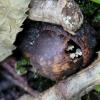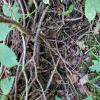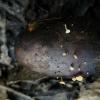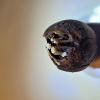
04-11-2025 09:07
Hello.A suspected Hymenoscyphus sprouting on a thi

04-11-2025 12:43
 Edvin Johannesen
Edvin Johannesen
Hi! One more found on old Populus tremula log in O

03-11-2025 21:34
 Edvin Johannesen
Edvin Johannesen
These tiny (0.4-0.5 mm diam.), whitish, short-stip

28-10-2025 15:37
Carl FarmerI'd be grateful for any suggestions for this strik

03-11-2025 16:30
 Hans-Otto Baral
Hans-Otto Baral
Hello I want to ask you if you have found this ye

28-10-2025 19:33
 Nicolas Suberbielle
Nicolas Suberbielle
Bonjour à tous,Je voudrais votre avis sur cette r
Habitat: Found yesterday (late August) after some rain, on acorns and cupules of Quercus robur, in damp and shady areas under a dead hedge fence (stacked dead wood), generally quite a damp muddy area, in mixed deciduous woodland with lots of Quercus and Corylus, ~25m elevation, Lower Weald, England.
Apothecia: Several with 0.5-1.5 mm diameter and some larger ones observed, < 10 mm stipe length depending on evironment, initially whitish and more translucent, yellowing with age (especially noticeable on disc), singular to caespitose, superficial, cyathiform and eventually discoid, margin more whitish and often undulating when mature, appearing to display geotropic growth and growing out of holes in the acorns.
IKI: Rings bb, hymenoscyphus-type, VBs with strongly dextrinoid reaction.
Spores: Elongated lacrymoid in face view, base acute and apex hemispherical, constricted at the middle and scutuloid in profile view, many small to medium VBs and some tiny LBs, appearing aseptate and uninucleate.
Free spores measured in water: 17.3-20.6 (21) x 4.4-4.7 um, Q = (3.7) 4-4.6 (4.7), n = 14, mean 19.3 x 4.5 um, Q mean = 4.2.
Asci: Cylindrical-clavate, apex appears acute-truncate, 8-spored, poroid, simple septa (furcations not clearly observed).
Paraphyses: Narrow cylindrical, with many small VBs, especially towards apex, apparently several at least 2-septate, most branching close to the base.
Ectal ex: Looks like textura prismatica (typica?), some narrower external hyphae with VBs.
Medullary ex: Looks like textura intricata.

Do you recognise any subgroups or varieties?
On IF, 'var. carpini' was elevated to species level by Gminder (2016). I guess on acorns in Western Europe with typical morphology would suggest this collection is 'var. fructigenus'.

I have seen similar apothecia on acorns before but not on hazelnuts. I can look more though as there are many around in the same wood and even close to where I found these acorns. It also seems interesting that they grow on the cupules as well as what seems to be the pericarp.
I can't find any discussion of an anamorph of H. fructigenus. Although I did find this interesting paper looking at mating genes in genomes of Leotiomycetes. I haven't read it properly yet, but they suggest many H. spp., including H. fructigenus, are homothallic. Presumably outcrossing between individuals on different nuts, if possible, would then be rarer anyway.
Wilson AM, Coetzee MPA, Wingfield MJ, Wingfield BD. Needles in fungal haystacks: Discovery of a putative a-factor pheromone and a unique mating strategy in the Leotiomycetes. PLoS One. 2023 Oct 12;18(10):e0292619.
https://www.ncbi.nlm.nih.gov/pmc/articles/PMC10569646/






 Macro-0001.jpeg
Macro-0001.jpeg